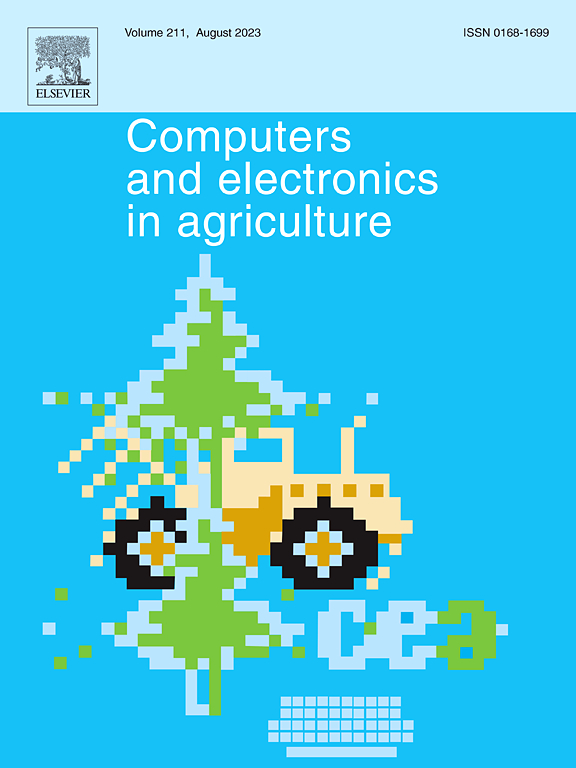不同土壤类型全饱和时导热系数的神经网络估计
IF 8.9
1区 农林科学
Q1 AGRICULTURE, MULTIDISCIPLINARY
引用次数: 0
摘要
土壤导热系数(λ)与土壤热传导直接相关。已经开发了许多模型来估计土壤热导率,但它们的适用性通常仅限于特定类型的土壤。考虑到土壤保水曲线和λ与含水量(θ)曲线之间的相似性,Lu和Dong提出了一个λ(θ)模型,该模型可以为各种土壤提供准确的λ估计,但不收敛于饱和土壤(λsat)的饱和导热系数值。在本研究中,我们发展了一种修正形式的Lu和Dong (MLD)模型。此外,我们提出了一种神经网络(NN)方法来估计MLD模型的参数,该模型使用土壤孔隙度、沙子、淤泥和粘土含量以及土壤固体的导热系数(λs)作为输入特征。训练神经网络对超参数进行优化,在超参数整定过程完成后,利用这些超参数建立NN-MLD模型。然后用独立的测试数据集对NN-MLD模型进行测试,并与从文献中提取的五个预先存在的模型进行比较。结果表明,NN-MLD模型在4个误差指标上优于其他模型,归一化均方根误差(NRMSE)为0.049,平均绝对误差(MAE)为0.098 W m−1 K−1,赤池信息准则(AIC)为- 1699,决定系数(R2)为0.94。此外,不同饱和度(S)的误差分析表明,NN-MLD模型在整个饱和度范围内始终优于其他模型,其优势在中等饱和度下最为明显,其中其他模型产生的nrmse和MAEs值是NN-MLD模型的三倍。NN-MLD模型在补充资料中的Python代码中可用。本文章由计算机程序翻译,如有差异,请以英文原文为准。
Neural network estimation of thermal conductivity across full saturation for various soil types
Soil thermal conductivity (λ) relates directly to heat conduction in soil. Numerous models have been developed to estimate soil thermal conductivity, but their applicability is often limited to specific types of soils. Recognizing the similarity between the soil water retention curve and the λ versus water content (θ) curve, Lu and Dong presented a λ(θ) model, which can provide accurate λ estimates for various soils but does not converge to the thermal conductivity value of a saturated soil (λsat) at saturation. In this study, we develop a modified form of the Lu and Dong (MLD) model. Additionally, we present a neural network (NN) approach to estimate parameters of the MLD model using soil porosity, sand, silt, and clay contents, as well as the thermal conductivity of soil solids (λs) as input features. The neural network is trained to optimize the hyperparameters, which are used to establish the NN-MLD model after the hyperparameter tuning process is completed. The NN-MLD model is then tested with an independent testing dataset and compared with five pre-existing models taken from the literature. Results show that the NN-MLD model outperforms the other models across four error metrics with a normalized root mean square error (NRMSE) of 0.049, a mean absolute error (MAE) of 0.098 W m−1 K−1, an Akaike’s information criterion (AIC) of −1699 and a coefficient of determination (R2) of 0.94. In addition, error analysis across varying degrees of saturation (S) reveals that the NN-MLD model consistently outperforms the other models across the entire range of saturation levels and its superiority is most pronounced at medium levels of saturation, where the other models yield NRMSEs and MAEs values three times larger than those of the NN-MLD model. The NN-MLD model is available in Python code in the Supplementary Material.
求助全文
通过发布文献求助,成功后即可免费获取论文全文。
去求助
来源期刊

Computers and Electronics in Agriculture
工程技术-计算机:跨学科应用
CiteScore
15.30
自引率
14.50%
发文量
800
审稿时长
62 days
期刊介绍:
Computers and Electronics in Agriculture provides international coverage of advancements in computer hardware, software, electronic instrumentation, and control systems applied to agricultural challenges. Encompassing agronomy, horticulture, forestry, aquaculture, and animal farming, the journal publishes original papers, reviews, and applications notes. It explores the use of computers and electronics in plant or animal agricultural production, covering topics like agricultural soils, water, pests, controlled environments, and waste. The scope extends to on-farm post-harvest operations and relevant technologies, including artificial intelligence, sensors, machine vision, robotics, networking, and simulation modeling. Its companion journal, Smart Agricultural Technology, continues the focus on smart applications in production agriculture.
 求助内容:
求助内容: 应助结果提醒方式:
应助结果提醒方式:


